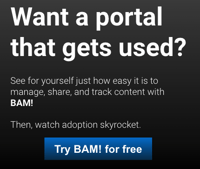Taking Control of the Conversation
For the enterprise seeking to reach today’s digital audience, user-generated content (UGC) presents a fascinating opportunity.
Your organization is already, and will always be, the subject of discussion by customers, candidates, user communities, and employees current and former. Relatively recent advances in technology have freed community-driven content from the phone lines and rumor mills and moved it into the digital space, with individuals uploading images, videos, comments and reviews that are available for anyone to see. In many ways, customer and employee voices are more empowered than ever, leaving businesses with the challenhttps://www.pop-art.com/2016/09/12/4-characteristics-of-the-modern-digital-customer-and-what-it-means-for-your-business/ge of promoting positive UGC while mitigating the negative.
See 4 examples of successful UGC campaigns >
Businesses that have fallen behind the UGC trend now find themselves responding to information—or misinformation—that is magnified and accelerated like never before. Left unmanaged, it can create the need for costly image and brand repairs. We’ve heard countless times from businesses who wish they could make that one really bad review – which causes disproportionate harm and often times simply isn’t true – go away. While scrubbing the past is nearly impossible, what can be done is to take control of the conversation moving forward.
In the coming years, UGC will increasingly affect the fates of brands, political movements, and individuals. We believe that enterprises are best served by developing the internal expertise to make a positive impact on this conversation.
However, an enterprise cannot participate in this conversation the same as an individual can. Organizations risk credibility by attempting to fabricate positive UGC or by forcing employees to create content masquerading as “organic.” Thorough, thoughtful strategies are required to ensure that the right content finds its way to the most eyes.
Pop Art has spent the last decade helping enterprise-level organizations foster valuable, authentic UGC. In our experiences, we have found that each UGC campaign requires its own strategizing and finessing, but there are three key elements present in the most successful UGC programs.
1. People Before Platforms
People have always been compelled to express their opinions and tastes publicly. UGC is not new in that regard, but the power of the platform is.
No longer relegated to town square soapboxes or letters to the editor, UGC achieves historically unparalleled fluidity courtesy of Facebook, LinkedIn, Twitter, and the other social media platforms.
Power now rests with the content creators, who use their platform of choice to be heard. Users who voluntarily testify their feelings inherently have more authentic value than a paid advertisement. Your UGC campaigns can harness that, but the campaign needs to prioritize the users over the technology or the process. The first and last consideration always needs to be the people – the “U” in UGC.
What sort of content resonates with your customers or employees on social media? What do they truly get excited about? Are there any particular individuals who embody your perfect brand ambassador? The power of UGC is about amplifying positive experiences of real people.
2. Define Your Goals to Show Value
Can UGC have an ROI? Absolutely. Like any ROI discussion, there are these basic elements:
- How much will UGC cost?
- Will it deliver tangible returns?
The most important first step is to have clearly defined goals. What outcome is intended from your UGC campaign? More leads? An uptick in site traffic? Improvement in customer perception?
Depending on your goals, KPIs can be defined to determine your ROI. In our experience, the most successful projects are those that kick off with a work session to define goals and determine required actions that will ensure clear understanding and clean data throughout the campaign.
Clearly define goals and how they will be measured. Over time, your metrics will allow you to analyze and iterate on your UGC campaigns to improve effectiveness. Integrate with your marketing campaigns to create great case studies that clearly demonstrate value.
3. Believe in Momentum
Like many other facets of marketing, UGC campaigns are powerful because of the momentum they build. Whether an employee-driven initiative, a magnified product promotion, or a full corporate rebrand, UGC typically starts out slowly and then grows exponentially as users follow in the footsteps of early adopters and engage with the campaign.
Once up and running, a buzzing, active user network can be your business’ secret weapon. On-demand, targeted UGC is virtually unheard of, but it can be surprisingly effective in mobile sales enablement.
Be thorough in setup and patient in practice. Setting things up the right way – unanimous stakeholder buy-in, appropriate checks and balances, clear desired outcomes, proper training – will set the gears in motion. Meaningful results might take months to come your way – be patient and try not to tinker!
User-Generated Content: A Platform for People
Brands all over the world are already running UGC campaigns with high levels of success. The conversations that are happening right now about your company will continue – whether you choose to be a part of them or not is up to you.
Topics for discussion: How is user-generated content already affecting your organization? How would you like it to in the future?


